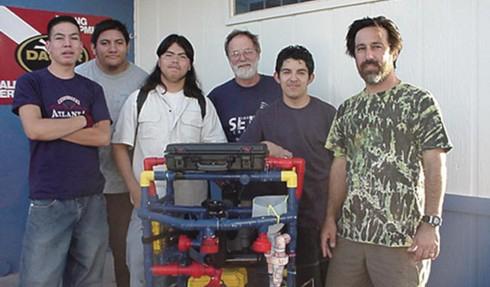How undocumented high-schoolers from Arizona beat MIT at the nation’s top robotics competition
From left: Oscar Vazquez, Luis Aranda, Lorenzo Santillan, Allan Cameron, Cristian Arcega, and Fredi Lajvardi with ‘Stinky,’ their prize-winning underwater rover, in 2004.
In 2004, four teenagers from an impoverished Arizona high school entered an underwater robotics contest. They had no money, and even less experience, but the robot they created, dubbed "Stinky," went head to head with the engineering geniuses at MIT — and won.
It's the kind of true story Hollywood screen writers leap for. And now the film version is officially being released. Called, "Spare Parts," it chronicles the improbable events and the unlikely confluence of personalities that led to their triumph at MATE, the nation's pre-eminent robotics competition sponsored by NASA and the Navy.
The movie is based largely on the reporting of Joshua Davis, who wrote about the team's success in Wired Magazine in 2005. Davis is also out with a new book: "Spare Parts: Four Undocumented Teenagers, One Ugly Robot and the Battle for the American Dream."
"The triumph of these four guys has inspired an entire generation of students at Carl Hayden," Davis says. "But unfortunately the experience of these four guys right after the events and during the subsequent ten years has not been entirely rosy. And, of course, the Hollywood film ends 10 years ago, which is part of the reason why I wrote the book."
All four of the students, Oscar Vazquez, Cristian Arcega, Lorenzo Santillan and Luis Aranda, were born in Mexico and brought across the border illegally as children. "Though they grew up in Arizona and viewed themselves as Americans, the law did not. They lived with the daily threat of deportation," Davis writes in a recent opinion piece in the New York Times.
And, sadly, it was their undocumented status that prevented them from going to college and blocked their paths to productive careers in the US, despite their obvious talent and ingenuity.
In 2004, Carl Hayden High School in West Phoenix, an urban high school with the motto, "The Pride's Inside," was made up almost entirely of Latino students. Between 70-80 percent of the students lived below the poverty line. "The school was known, if it was known at all, for gang violence," Davis says.
In an effort to try to balance the races at the school, the district decided to try to create programs that would attract white students. It didn't work. Nevertheless, they created a marine science program, which, in the case of a high school nowhere near an ocean, doesn't seem the most obvious choice. But as often happens, two inspired (and inspiring) teachers took the idea and ran with it.
The teachers, Freddy Lajvardi and Allan Cameron, "came up with the craziest thing they could imagine," Davis says: "To create a program, build a robot and enter it into a national underwater robotics competition sponsored by NASA and the US Navy. This, despite the fact that they're in the middle of the desert, and they don't even have a swimming pool."
Cristian Arcega, already set apart from much of the student body because he was a "brainiac," was intrigued. "I wanted a way to apply everything that I learned in school and also a way to challenge myself more," Arcega recalls.
Arcega says he and the others basically met for the first time when they began to work on the competition. "Oscar and Luis were both seniors, so Lorenzo and I didn't have any classes with them. We hardly ever saw them outside of the actual robot building, because none of our schedules lined up," Arcega says.
Though excited by the project, none of them had any thoughts about winning. In fact, Arcega says, that's the reason they entered the competition at its highest level, where they would be up against universities instead of other high schools. "We figured, well, we're probably going lose to the high schools because it's our first year doing this, so we might as well compete against the universities. Then, if we lose, it doesn't feel quite as humiliating, and if we happen to beat one school, that's something you can brag about," he says.
Joshua Davis says the students "approached the problem with an immense amount of ingenuity…Oftentimes, students [from top schools] take the same classes and they have the same ideas — there's not a lot of completely new, out of the box thinking….These four guys from Carl Hayden Community High School started with a blank slate."
In the news stories and debates involving undocumented students and their families, stories about creative geniuses like this group of high school kids are rare. But Cristian Arcega knows they are out there, many of them aching for an opportunity to do something important.
"I've personally met thousands and thousands of them," he says. "It's not as rare as you'd expect. It's just that the opportunities are so limited…The next time you have some undocumented person washing your car or cleaning your lawn, [realize] they were probably aiming to be in school and would prefer to be studying to be an engineer."
There are now about 10-15 graduating seniors every year in the robotics program at Carl Hayden High School — and typically half of them are women. "We have this joke now," Arcega says. "If you meet a Latina engineer from Arizona in her 20s, ask her what year she graduated from Carl Hayden High School, because odds are that's where she came from."
This story is based on an interview that aired on PRI's Science Friday with Ira Flatow
